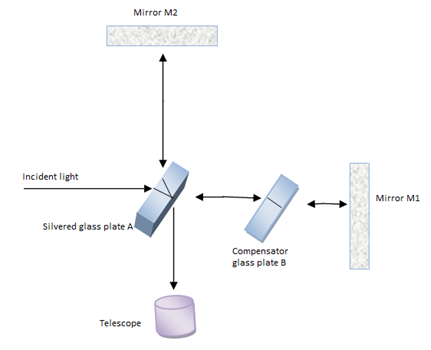Question 3: In Michelson Interferometer a second glass plate is also used, why?
ANSWER
We know that;
(1) A straight line is the shortest distance between two points.
(2) Light refracts when it enters from one medium to another.

Now let’s consider the construction of the Michelson’s interferometer. There are two glass plates A and B, as shown in the diagram. Plate A is slightly silvered at the back end and this plate acts as beam splitter. There is one another plate B called a compensating glass plate and we are discussing the purpose of this plate in this question. There are two mirrors M1 and M2 which reflects the two parts of the beam.
A monochromatic beam of light falls on plate A and passes on the plate till it is partly reflected from the silvered face and partly transmitted through it. This is the first passage of the light from the glass plate A. The reflected part of the beam passes the same glass plate once again (for the second time) and reaches the mirror 2. It is reflected from the mirror 2 and passes the glass plate for the 3rd time to reach the telescope.
Now consider the second part of the ray which is transmitted through the glass plate A (one passage) and travels toward mirror M2. Suppose there is no glass plate B on its way at the moment. At M2, it is reflected back toward M1 and reflected from its back silvered side and reaches the telescope. Here the two rays (from M1 and M2,respectively) interfere with one another. Now, the first part passes through the glass plate A thrice and undergoes a refraction every time (changing path). On the other hand, the second part of the beam, passes only once through the glass plate A. Therefore, the first part travels more optical distance than part 2.
So to equalize the path difference, a second glass plate B is introduced in the path of ray 2 which it passes two times, in going toward and coming back from mirror M1. So the second ray also has three passages from the glasses and travels the same optical distance. Thus the distances of both the rays are equalized. This is the reason it is called a compensatory glass plate.

Pingback:Physical Optics, Conceptual Questions, Physics 11 – msa
Pingback:Brewster’s law of polarization – msa
Pingback:interference-and-diffraction – msa
Pingback:1510